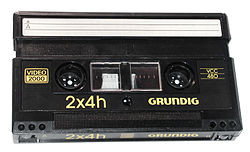This article has multiple issues. Please help improve it or discuss these issues on the talk page . (Learn how and when to remove these messages)
|
 | |
 A Video 2000 videocassette | |
| Media type | Magnetic cassette tape |
|---|---|
| Encoding | PAL |
| Standard | 625 lines |
| Developed by | Philips Grundig |
| Usage | Home movies |
| Released | 1979 |
| Discontinued | 1988 |
Video 2000 (also known as V2000, with the tape standard Video Compact Cassette, or VCC) is a consumer videocassette system and analogue recording standard developed by Philips and Grundig to compete with JVC's VHS and Sony's Betamax video technologies. [1] It was designed for the PAL color television standard, but some models additionally handled SECAM. Distribution of Video 2000 products began in 1979 exclusively in Europe, South Africa and Argentina and ended in 1988. [2]
Contents
- The Video Compact Cassette
- Tape lengths
- Format and features
- Launch
- Machines
- References
- External links
Although some initial models and advertising featured a mirror-image "VCR" badge based on the logo of Philips's earlier Video Cassette Recording (VCR) system, Video 2000 was an entirely new (and incompatible) format, which incorporated many technical innovations. [3] Despite this, the format was not a major success and was eventually discontinued, having lost out to the rival VHS system in the videotape format war.



